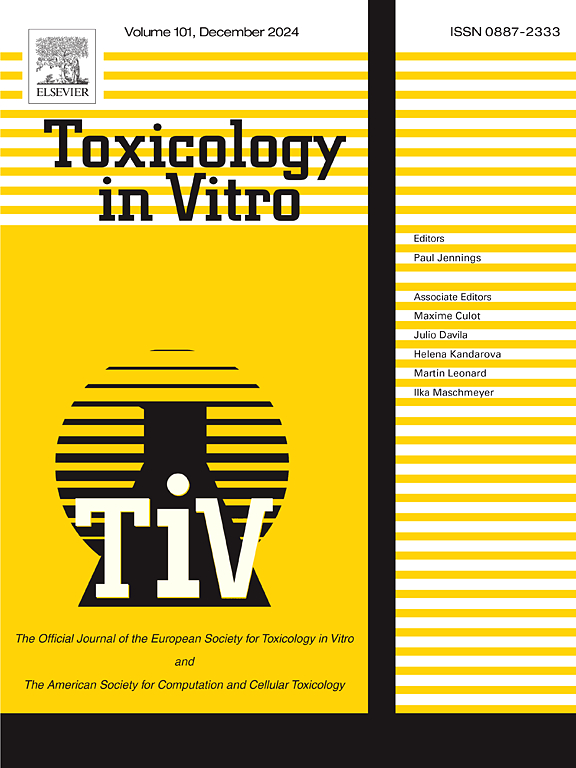Ozone and particulate matter co-exposure at the air-liquid interface: Establishing an approach to assess pollutant interactions in vitro
IF 2.6
3区 医学
Q3 TOXICOLOGY
引用次数: 0
Abstract
Background
Air pollution is a complex mixture of gases and particulates that varies spatially and temporally, making attribution of adverse effects to specific individual air pollutants a challenge. To disentangle effects of mixtures in a controlled setting, reproducible and realistic co-exposures of human-relevant models to gaseous and particulate pollutants are needed. Although air-liquid interface (ALI) exposures offer considerable promise as non-animal models for inhalation toxicity testing, a lack of studies comparing individual and co-exposures to gaseous and particulate pollutants has thus far prevented assessment of their strengths and limitations for disentangling effects of pollutant mixtures.
Methods
Using an integrated ALI exposure system, we characterized the interaction between ozone and particles (25 nm fluorescent polystyrene beads) to assess effects on and reproducibility of critical physical endpoints including temperature, humidity, ozone concentration and particle deposition. Particle deposition and concentration were assessed via three independent methods: fluorescence, quartz crystal microbalance (QCM), and airborne particle count. To evaluate the acute biological effects of an air pollutant mixture in vitro, human lung type 2 epithelial-like cells (A549) were exposed at the ALI to air, ozone (O3), particles, and O3 + particles (co-exposure) for 1 h (n = 4 independent repeats/exposure type). Cell injury and inflammation were quantified by extracellular lactate dehydrogenase (LDH) activity and release of proinflammatory cytokines (interleukin (IL)-8 and IL-6) respectively 0 and 24 h post-exposure.
Results
Exposures were effective at delivering targeted O3 exposures under controlled temperature and relative humidity. In-well particle deposition and airborne concentration exiting the exposure system, quantified through parallel methods, were consistent, and increased in relation to aerosolized particle concentration. Levels of each pollutant were effectively maintained in the presence of the other. O3 alone, and co-exposure to O3 and particles, increased LDH release from A549 cells, indicating pollutant-specific cytotoxicity. In contrast, IL-8 and IL-6 release (24 h > 0 h) were not changed by exposure to the individual pollutants, but tended to increase following co-exposure.
Conclusion
The present work establishes the utility of ALI exposure systems to disentangle individual effects of pollutants from a mixture, and highlights the importance of direct experimental characterization of dosimetry and exposure conditions.
臭氧和颗粒物在气液界面的共同暴露:建立一种评估污染物相互作用的方法。
背景:空气污染是一种复杂的气体和微粒混合物,在空间和时间上各不相同,因此将不良影响归因于特定的单个空气污染物是一项挑战。为了在受控环境下厘清混合物的影响,需要让与人类相关的模型可重复地、真实地共同暴露于气体和颗粒污染物。尽管空气-液体界面(ALI)暴露作为非动物吸入毒性测试模型具有相当大的前景,但由于缺乏对单独暴露和共同暴露气态污染物和颗粒污染物的比较研究,迄今为止还无法评估其在区分污染物混合物效应方面的优势和局限性:方法:我们利用综合 ALI 暴露系统,描述了臭氧与颗粒物(25 nm 荧光聚苯乙烯珠)之间的相互作用,以评估关键物理终点(包括温度、湿度、臭氧浓度和颗粒物沉积)的影响和可重复性。粒子沉积和浓度通过三种独立的方法进行评估:荧光、石英晶体微天平(QCM)和空气中的粒子计数。为了在体外评估空气污染物混合物的急性生物效应,将人肺 2 型上皮样细胞(A549)在 ALI 处暴露于空气、臭氧(O3)、颗粒物和 O3 + 颗粒物(共同暴露)1 小时(n = 4 次独立重复/暴露类型)。通过细胞外乳酸脱氢酶(LDH)活性和暴露后0小时和24小时促炎细胞因子(白细胞介素(IL)-8和IL-6)的释放分别对细胞损伤和炎症进行量化:在温度和相对湿度可控的条件下,暴露能有效地进行定向臭氧暴露。通过平行方法量化的井内粒子沉积和从暴露系统排出的空气传播浓度是一致的,并且与气溶胶粒子浓度相关。每种污染物的浓度在另一种污染物存在的情况下都能有效维持。单独暴露于 O3 以及同时暴露于 O3 和微粒会增加 A549 细胞中 LDH 的释放,这表明污染物具有特异性细胞毒性。与此相反,IL-8 和 IL-6 的释放(24 h > 0 h)并不因暴露于单独的污染物而改变,但在共同暴露后有增加的趋势:结论:本研究证实了 ALI 暴露系统在从混合物中分离污染物的个体效应方面的实用性,并强调了剂量测定和暴露条件的直接实验特征的重要性。
本文章由计算机程序翻译,如有差异,请以英文原文为准。
求助全文
约1分钟内获得全文
求助全文
来源期刊

Toxicology in Vitro
医学-毒理学
CiteScore
6.50
自引率
3.10%
发文量
181
审稿时长
65 days
期刊介绍:
Toxicology in Vitro publishes original research papers and reviews on the application and use of in vitro systems for assessing or predicting the toxic effects of chemicals and elucidating their mechanisms of action. These in vitro techniques include utilizing cell or tissue cultures, isolated cells, tissue slices, subcellular fractions, transgenic cell cultures, and cells from transgenic organisms, as well as in silico modelling. The Journal will focus on investigations that involve the development and validation of new in vitro methods, e.g. for prediction of toxic effects based on traditional and in silico modelling; on the use of methods in high-throughput toxicology and pharmacology; elucidation of mechanisms of toxic action; the application of genomics, transcriptomics and proteomics in toxicology, as well as on comparative studies that characterise the relationship between in vitro and in vivo findings. The Journal strongly encourages the submission of manuscripts that focus on the development of in vitro methods, their practical applications and regulatory use (e.g. in the areas of food components cosmetics, pharmaceuticals, pesticides, and industrial chemicals). Toxicology in Vitro discourages papers that record reporting on toxicological effects from materials, such as plant extracts or herbal medicines, that have not been chemically characterized.
 求助内容:
求助内容: 应助结果提醒方式:
应助结果提醒方式:


